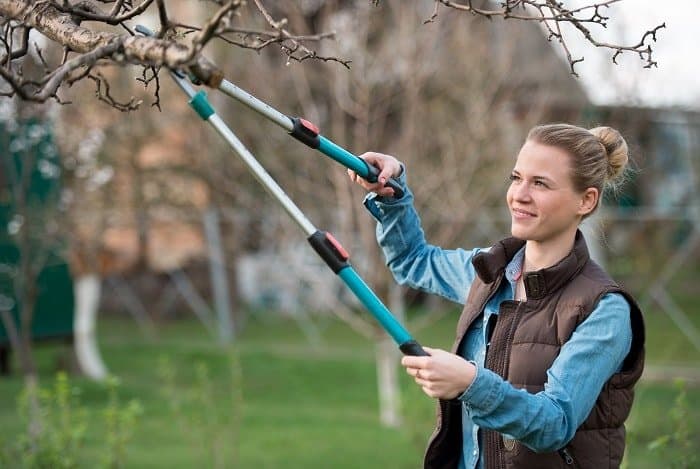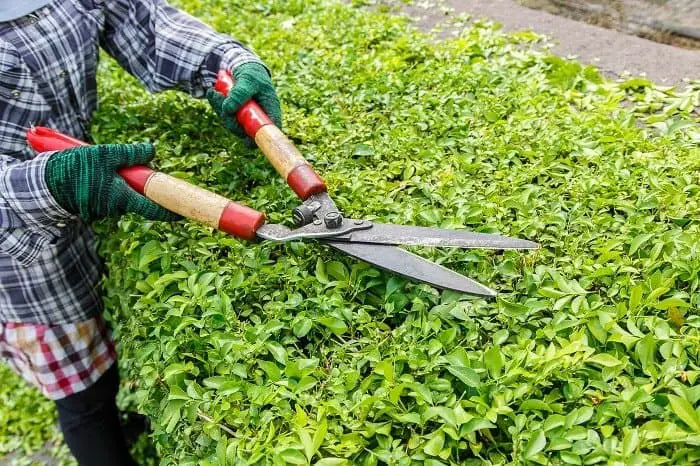Last Updated on December 22, 2022 by Griselda M.
Finding ways how to trim a burning bush? Read on to learn how to start.
The burning bush (Euonymus alatus) can grow huge in an uncontrollable manner as they mature. You might be wondering what ways to trim it down. It is crucial to know how to trim your burning bush the right way at the right time.
Trimming burning bush is done generally for the health of the plant. Ideally, trimming should be done in late winter or early spring, just before new growth starts to advance.
If you wish to reduce the size of the bush, shaping is needed. Or you might need an extreme rejuvenation trimming process.
Three Tips to Consider on How to Trim a Burning Bush
Trimming For Your Plant Health
Considering the health of the plant, you should trim your bush in late winter or early spring before new growth. When you assess trimming your burning bush for its health, you should only remove branches that are prone to spreading diseases throughout the plant.
Use a pruning shear to cut away dead branches. Make sure to cut down the whole branch of the diseased plant, down to its origin. This prevents diseases from spreading to other parts of the plant.
Cut the intertwined branches with a pruning shear. Cut them down to the point of origin rather than trim them down.
Read more about How to trim a lilac bush.
Pruning Burning Bush to Shape It
Late winter or early spring should be the best time for trimming your burning bush to shape it. Right before new plant growth develops.
You should also plan to prune twice a year. Trimming down the burning bush is a nice way of keeping them in check and shaping them into the desired look.
Using a hedge clipper or pruning saw, you can trim your burning bush into nice shapes such as a box, cube, or globe hedge shape. This process will open the middle of the shrub to sunlight and air throughout the plant. You should also trim the bush once more towards the middle of summer.
While you are trimming for shape, you should consider trimming for health maintenance and also to keep your plant in good shape.
Rejuvenation Trimming on a Burning Bush
If you neglect your burning bush for a long time, it will need renewal. This happens when you do not give your burning bush any trimming routine.
Rejuvenation trimming should be done in late winter or early spring. Rejuvenation trimming is the harshest or most serious form of pruning. You should only do rejuvenation trimming if your burning bush is overgrown.
If your plant grows back after the severe cut might be on your mind. Not to worry, your plant will definitely grow back strongly after a serious trimming.
Make sure the severe cut is clean and sharp so your burning bush can make a good and quick recovery. You may have to reschedule this process again every year until you get your desired trim till all the overgrown shrubs are gone.
Because the trimming was harsh and severe, you will need to water your bush consistently till it regains its strength.
Check this Compacta Burning Bush to give color to your garden, you can just do an annual pruning to this bush.
Tips to Take Note
- Trimming for health removes the bad branches, and helps your shrub stay healthy.
- Light trimming is just for shapes.
- Rejuvenation trimming is basically for your burning bush renewal.
How Much Does it Cost to Trim a Burning Bush?
Let us work on the assumption you are going to do this yourself because the bush has not become a tree and there is no risk to you yet. In this case, you need the right equipment. I have over time learned that buying inexpensive pruning equipment is very costly, as it breaks. On my path to self-sufficiency in producing energy, I discovered the Fiskars brand when looking for an axe able to split Eucalyptus logs. Fiskars products are tough, durable, and cleverly designed – and no – I get no benefit out of endorsing them.
For a burning bush trimming job, I would buy a set of these super pruners – they will cut up to about 1 1/4 inch thick branches. My parents and I share a set of these super pruners for our two properties, which were well worth the investment. The power gear thing magnifies the strength you can put into a branch, meaning you do not end up hurting your hands by cutting the thicker stems.
So if we look at it, it should cost about $17-24 dollars to get the equipment to trim the tree plus your time!
What Time of Year Do You Cut Back a Burning Bush?
You can actually cut these trees back at pretty much any time of year, but the best time of year is when it is dormant because then you can see what you are doing. Fall or early Spring before it starts shooting will be the easiest time to get in there and cut it down!
What is The Botanical Name For Burning Bush?
Euonymus alatus is the botanical name. Alatus means winged. It is often known as the winged spindle bush due to the use of various Euonymus species’ wood for making spindles used in the textile industry. Hence it is the winged Euonymus.
Was The Burning Bush a Thorn Bush?
By this, we assume you refer to the Burning bush in biblical texts, not the Euonymus alatus, burning bush. Given the location of the biblical occurrence of a burning bush, it is most likely this bush was a thorn bush. It was definitely not a Euonymus alatus, as these trees would not do well in a dry rocky environment.
How Much Sun Do Burning Bushes Need?
To achieve a beautiful plant with abundant leaves that can turn bright red in fall, it will require full sun to partial shade. It can grow in more shaded places, but will then not be as vibrantly colored. These plants are aggressive growers and can absorb a lot of sunlight, which is why full sunlight will give you the best show of red foliage in fall.
Can You Transplant a Burning Bush in The Summer?
You can, but it would be better to do so in fall, winter, or early spring when the tree is dormant. If you transplant it in summer, make sure to trim the plant back quite extensively before planting. When transplanting, remove the root ball from the ground and wrap it in hessian/burlap sacking. This method is great as you can tie the root ball up, move the plant and just lower it into the new hole, cover the whole bag and root ball with soil, and the burlap will eventually biodegrade into compost, and the roots can grow through it. In this way, you achieve minimal root disturbance.

Eunice is a gardener who loves to play in the dirt. She starts her day early in the morning, watering her plants and tending to her garden. She loves the smell of freshly cut grass and the feeling of sunshine on her back as she works. She‘s a master at creating beautiful flower arrangements and can often be found humming a tune as she tends to her plants. When she‘s not gardening, she loves to read books about nature and share her knowledge with others. Eunice loves gardening so much that she‘s even been known to talk to her plants!




